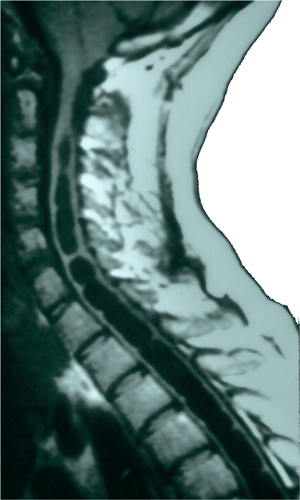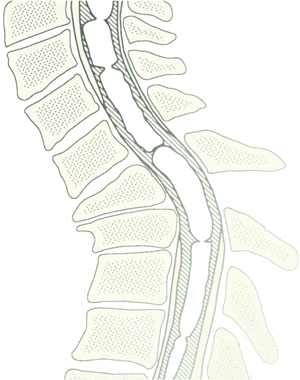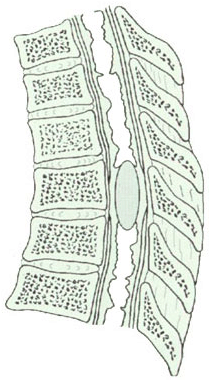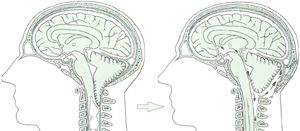SYRINGOMYELIA IN GENERAL
WHAT IS SYRINGOMYELIA?
 |
Syringomyelia is a disorder in which a cyst (from the greek syrinx, meaning “flute”) develops within the spinal cord. Over time, the cyst will expand upwards and downwards in the spinal cord, slowly and gradually destroying its core. This damage results in the loss of sensitivity for temperature (both hot and cold), for pain and for deep touch (the one that allows you to know the position of the joints in the body). This damage also results in the loss of the ability to sweat in the affected areas, and can also be associated to stiffness in the back of the neck, shoulders, arms and/or legs. Over time, bladder and bowel control may be affected, as well as sexual functions. The hands are most often and most severely affected, with atrophy of the intrinsic muscles of the hand. The legs are usually affected much later in the evolution of the disease. Occasionally, there may be intense pain in the back of the neck when coughing, voiding faeces, lifting weights or having sexual intercourse (typically in the moment of orgasm). Syringomyelia may affect both sides of the body but most often will do so asymmetrically, i.e. with different intensity and distribution at either side. |
|
Sagittal MR image in syringomyelia
|
Syringobulbia happens when the syringomyelitic cavities (syringes) involve the brainstem, the part of the brain that links the brain with the cerebellum and the spinal cord, and which controls respiration and heartbeat.
Symptoms usually begin in the adolescence or young adulthood and tend to develop slowly, though they may suddenly worsen with intense coughing or physical exercise (lifting a weight of considerable mass), or after trauma with spinal cord lesion.
If left untouched (without treatment), this condition may lead to progressive loss of sensitivity and strength in arms, especially in the hands. Over time, the areas with sensitivity loss may also show chronic pain that is similar to electrical shocks.
 |
 |
|
Atrophy of the intrinsic muscles of hand in syringomyelia
|
Painless burns in siringomlielia
|
CAUSES OF SYRINGOMYELIA
Cerebrospinal fluid (CSF) is a watery liquid that flows around the spinal cord and the brain, transporting nutrients to them and waste products away from them. The obstruction of the normal flow of CSF is the main cause of syringomyelia because it promotes cyst formation. The differences in pressure along the spinal cord will then promote the development of the cyst, damaging the spinal cord.
WHAT ARE THE DIFFERENT TYPES OF SYRINGOMYELIA?
There are 5 types of syringomyelia, according to incidence:
- 80% syringomyelia secondary to Chiari malformation type I and type II.
- 15% post-traumatic syringomyelia.
- 4% syringomyelia secondary to hydrocephalus.
- 1% syringomyelia secondary to arachnoiditis.
- Tumoural syringomyelia (rare).
 |
Chiari malformations type I and type II are produced in the development of the foetus and involve brainstem and cerebellum herniation, i.e. downward displacement of critical structures located underneath the cerebral hemispheres, impeding the exit of CSF into the spinal cord and so promoting cyst formation in the cervical region of the spinal cord. In this case, symptoms usually first appear when the patient is between 25 and 40 years old. |
|
Chiari malformation type I causing syringomyelia
|
 |
Post-traumatic syringomyelia is produced after a fracture of the spine with spinal cord lesion takes place. This induces fibrosis around the spinal cord at the site of lesion, so CSF cannot flow correctly and a syringomyelitic cavity is formed. The symptoms may appear months or even years after the initial lesion, starting with pain, weakness, and sensitive deterioration originated at the site of lesion.
|
|
Post-traumatic syringomyelia
|
Hydrocephalus involves the pathological increase of the volume of CSF inside the brain. In very exceptional cases it is accompanied by syringomyelia.
Arachnoiditis involves the inflammation (swelling) of a membrane surrounding the spinal cord named the arachnoid. This interferes in the free flow of CSF, promoting syringomyelia. The causes of arachnoiditis are varied, and amongst the most common we find tuberculose meningitis and cysticercosis.
 |
In tumoural syringomyelia there is a tumour that secretes a protein-rich substance that promotes the formation of a cyst above and another one below the tumour. These cysts disappear on removal of the tumour.
|
|
Intramedullary tumour causing syringomyelia
|
Some cases of syringomyelia have a familial incidence, though this is extremely rare.
HOW IS SYRINGOMYELIA DIAGNOSED?
Syringomyelia is suspected on clinical examination and confirmed using MRI. MRI will not only show syringomyelitic cavities, but also any other condition that is causing the syringomyelia (Chiari malformation type I, tumour, ect.).
HOW IS SYRINGOMYELIA TREATED?
Medication is not curative in syringomyelia, and radiotherapy is not used because it is useless except when the cause of the syringomyelia is a tumour. Surgical treatment is, thus, usually recommended. In most cases it results in the stabilisation or very modest improvement of the symptoms, but, if surgery is delayed, irreversible lesions in the spinal cord may be produced and so it is strongly recommended to avoid unnecessary waiting.
When the cause of the syringomyelia is Chiari malformation type I, the objective of surgery is to make more space for the base of the skull and upper neck, thus allowing a correct CSF flow. This usually results in the disappearance of the syringomyelitic cavity.
 |
 |
|
Decompression of cranio-cervical junction to treat Chiari malformation type I causing syringomyelia
|
Decompression to treat post-traumatic syringomyelia
|
In the case of post-traumatic syringomyelia, the main goal of surgery will be to decompress the spinal cord at the site of the initial lesion, allowing CSF to flow freely up and down.
If a tumour is causing the syringomyelia, the treatment would involve removing the tumour. This usually eliminates the syringomyelitic cavity. Occasionally, it may be necessary to drain the syringomyelitic cavity using a catheter running from the cyst to the peritoneal cavity (syringe-peritoneal shunt) or pleural cavity (syringe-pleural shunt). The shunt may stop the progression of symptoms, but recurrences (the syringomyelitic cavity is formed again) are common. The decision whether to insert a shunt or not requires extensive assessment, for this procedure carries the risk of injury to the spinal cord, infection, blockage, or haemorrhage, and unfortunately does not work in all patients. Despite everything, surgical treatment is not always successful, but it is the only effective treatment.
 |
|
Syringe-pleural shunt
|